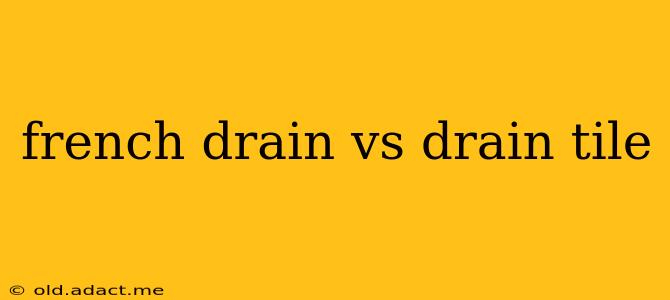Choosing between a French drain and drain tile often leaves homeowners feeling overwhelmed. While both systems effectively manage excess water, they differ significantly in their design, installation, and suitability for various situations. This comprehensive guide will clarify the key distinctions, helping you make an informed decision for your property's drainage needs.
What is a French Drain?
A French drain, also known as a perforated drain, is a subsurface drainage system typically comprised of a perforated pipe surrounded by gravel. This gravel acts as a filter, allowing water to seep into the pipe and be channeled away from the problem area. The pipe itself is usually corrugated plastic, although other materials can be used. French drains are versatile and can be installed in various locations, including around foundations, along slopes, and in low-lying areas. They're a popular choice for both residential and commercial applications.
What is Drain Tile?
Drain tile, often referred to as agricultural drain tile or field tile, primarily serves agricultural and larger-scale land drainage projects. It's typically made of clay or concrete, though newer plastic options are also available. These tiles are usually larger in diameter than French drain pipes and often laid in a network of trenches to efficiently collect and move water from a larger area. They are designed to handle significant volumes of water and are less frequently used in smaller residential applications.
French Drain vs. Drain Tile: Key Differences
Here's a table summarizing the key differences between French drains and drain tiles:
| Feature | French Drain | Drain Tile |
|---|---|---|
| Material | Typically perforated plastic pipe | Clay, concrete, or plastic pipe |
| Size | Smaller diameter pipes | Larger diameter pipes |
| Installation | Simpler, often DIY-able | More complex, usually professional |
| Scale | Smaller areas, localized drainage | Larger areas, extensive drainage |
| Cost | Generally less expensive | Generally more expensive |
| Maintenance | Relatively low | Can require more frequent maintenance |
| Typical Use | Residential, foundation drainage | Agricultural, large-scale projects |
What type of drainage system is best for my home?
The best drainage system depends entirely on your specific needs and property conditions. Consider these factors:
How much water needs to be drained?
For smaller areas with localized water problems (e.g., a wet basement), a French drain is typically sufficient. For larger areas with significant water accumulation, drain tile may be more appropriate.
What is the size of the area needing drainage?
French drains are ideal for smaller areas, while drain tile systems are designed for larger areas requiring extensive drainage solutions.
What is the soil type on your property?
The soil type impacts both installation and effectiveness. Well-draining soil may only require a simple French drain, while clay soils may need a more robust system, potentially involving drain tile.
What is your budget?
French drains generally cost less to install than drain tile systems.
What are the local regulations regarding drainage?
Check local building codes and regulations before starting any drainage project.
Is it possible to install a French drain myself?
While many homeowners successfully install French drains themselves, it's crucial to understand the process thoroughly before attempting it. If you're uncertain about any aspect of the installation, consulting a professional is always recommended. Improper installation can lead to ineffective drainage or even damage to your property.
What are the common problems with French drains and drain tiles?
Both French drains and drain tiles can encounter issues, such as clogging from sediment or roots. Regular maintenance, including flushing or cleaning, can help prevent these problems and ensure long-term effectiveness.
This detailed comparison clarifies the differences between French drains and drain tiles, equipping you to make the best choice for your specific drainage needs. Remember, consulting with a landscaping or drainage professional can provide personalized advice and ensure a successful project.
